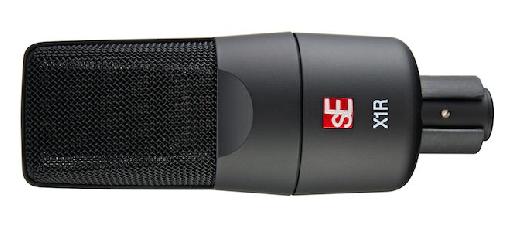sE has released a raft of new microphones based on the core design of its well-recieved X1, each with a different twist, be it USB connectivity or integrated tube circuitry. The X1R's take on the concept is that it is a ribbon mic, and at £119 ex VAT it's aggressively priced for a ribbon, aiming to give producers a way into the world of ribbon mic recording without spending a fortune.
The X1R's body is similar to its siblings, and it's very solidly built and finished in matte black metal. Since it's passive there's no power unit and you mustn't use phantom power, and there are no body mounted controls at all. Simply connect it to your interface or desk and you're ready to go. With passive mics, your preamps are even more important than usual, so you'll get the most out of by making sure you are using some decent ones. It uses a state of the art ribbon element enclosed by Neodymium magnets and combines sE's traditional ribbon technology with some of the mechanical elements of the company's Voodoo mic high frequency extension technology to produce an authentic sounding ribbon mic with a gentle high frequency lift.
Nuts and bolts
The X1R doesn't offer the full frequency response performance of sE's higher end ribbon mics like the Rupert Neve RNR1, but then it is far more affordable. What you do get however is a hybrid of old and new ribbon technology that sE says gives you the open, natural sound of a classic ribbon mic but without some of the difficulties that can be associated with using ribbons as a type of recording microphone. It has a frequency response of 20'"16 kHz, a figure of 8 directional pattern and a maximum SPL of 135 dB which should cope with some pretty loud sounds.
sE suggests the X1R is suitable for recording a variety of sources including overhead drums, guitar cabs, strings, woodwind, brass and also for commercial broadcast and voiceover applications. In our tests it was very accurate, giving a startlingly clear reproduction of the sounds as I was hearing them in the room. Electric guitar was crisp and sharp, vocals were warm and intimate and even acoustic guitars sounded pretty good with a bit of careful mic positioning. Ribbon mics let you get away with adding quite a lot of high EQ to add air to the signal and this worked particularly well on the sounds in our tests.
Since the mic is passive you are more reliant on your mic preamps and on a cheaper interface I found that pushing the signal hard did introduce a little noise. However switching to a higher end interface solved this, the quality of the preamps shining through and letting me boost the gain of the signal significantly without any adverse side effects. There can sometimes be a perception that ribbon mics are only suitable for very specific recording tasks but the X1R seems like a great all-rounder and a useful alternative to a capacitor or cardioid model when you want a different kind of sound, perhaps a smoother and more rounded quality. At this price it's not going to break the bank either so it's a definite contender for your studio arsenal.
Price: $199 USD / £119 Ex VAT Pros: Smooth ribbon sound. Good on a range of sources. Very affordable. Solid build. Cons: Works best with good quality preamps. |



 © 2024 Ask.Audio
A NonLinear Educating Company
© 2024 Ask.Audio
A NonLinear Educating Company
Discussion
Want to join the discussion?
Create an account or login to get started!